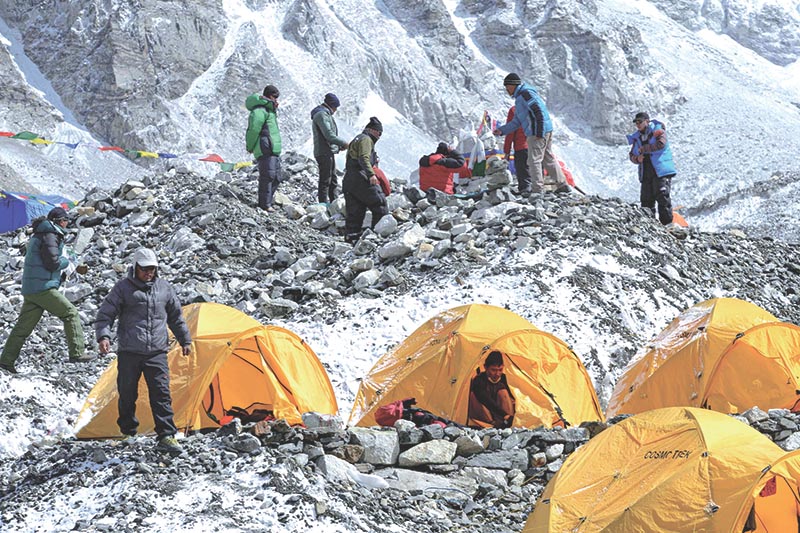Mountain guides hope autumn season brings relief
KATHMANDU, JULY 22
The government has lifted lockdown from today, allowing all trekking, mountaineering and travel firms to begin their services. The move had filled tourism stakeholders with hope of gradual recovery.
The upheaval caused by the coronavirus pandemic and the subsequent lockdown and travel restrictions have hit the tourism sector the hardest, leaving more than a million tourism workers — 300,000 directly engaged in the industry — out of work. Of them, the plight of mountaineering sector workers is the worst and they are pinning their hopes on the autumn season as the government has allowed them to resume expedition operations too.
Tourism Secretary Kedar Bahadur Adhikari said that the Ministry of Culture, Tourism and Civil Aviation plans to resume all tourism-related activities by following the standard health protocols.
According to Tashi Lakpa Sherpa, an expedition leader, a number of foreign climbers are willing to visit Nepal for the autumn expedition. Along with the government’s announcement, the stakeholders will now begin their preparations for the expedition, he said.
“Each day we are receiving calls and e-mails from our clients, who are interested in going on expeditions,” he said, adding that the announcement of the government is a relief for the industry and particularly for the workers who have remained jobless for a long time. He, however, said that the expedition activities might not be as smooth as earlier, thus it is unlikely that all workers will be able to get back to work.
Mira Acharya, director of Department of Tourism (DoT), informed that the department is in fact making internal preparations in coordination with stakeholders for the autumn expedition.
“This is the right time to make preparations for the autumn season,” she said, “Major peaks can be opened for the expedition following the health safety protocols.”
Needful discussions with stakeholders will be held on how to resume the expedition activities by following health safety protocols, she added.
With the spring season cancelled, a number of mountain workers have basically been jobless since last year’s autumn season, which means nearly a year now. “But even if the expedition is reopened, the number of climbers is expected to be less, which inevitably means not all workers will get work,” said Maya Sherpa, second vice-president of Nepal Mountaineering Association (NMA).
With recovery of the industry expected to take at least a year, the major concern is to sustain the workers, Maya said.
The government has announced alternative jobs for the affected workers, such as peak cleaning, identifying routes and other works. “But due to the monsoon, everything has been halted,” said Maya, adding the workers are hoping to continue the alternative works till things go back to normal.
According to the DoT, even though a few workers are managing somehow during this pandemic, most are struggling and the number of workers seeking work is increasing each day.
Primarily a seasonal job, those engaged in the mountaineering sector are employed only during the spring and autumn seasons. While their earning during the two seasons is enough to sustain them throughout the year, the spring season had to be cancelled this year because of the contagion.
It is estimated that the government lost Rs 600 million in revenue due to the cancelled expeditions in the spring season this year. The figure does not account for the losses faced by the workers, which is estimated at billions of rupees.
“There are around 2,000 to 2,500 mountain guides and sardars in the country. Of them, only around 60 are internationally certified guides, who conduct expeditions in other countries also and work round the year. The other nationally certified guides are dependent on two seasons only and are in crisis due to the COVID-19 pandemic,” said Lakpa Sherpa, instructor guide who is also the president of Nepal Mountaineering Instructor Association.
As per him, normally guides and sardars get fixed salary for the whole expedition, while other workers like cooks, kitchen boys and climbing supporters are daily wage earners. “These daily wage workers are in more trouble.”
Generally cooks, kitchen boys and climbing supporters get paid around $1,500 per day. While the cook and kitchen boy earn Rs 300,000 to Rs 400,000 per expedition, the pay of the climbing supporter depends on the weight they transport and how father up they are required to carry the equipment.
Similarly, guides and sardars receive around Rs one million to Rs 1.2 million to climb peaks above 8,000 metres.
“Such guides only take one expedition per season as it takes around 40 to 60 days to climb peaks above 8,000 metres,” he said.
“Guides who climb peaks above 7,000 metres earn around $1500 a day. It takes at least a month to climb a 7,000-metre peak.”
In the meantime, guides who scale the peaks up to 6,000 metres can work two or three times per season as it takes up to 20 days to climb such peaks, Lakpa added. For peaks up to 6,000 metres, guides earn around $300 a day.
Meanwhile, the government has also announced plans to establish a fund to provide relief for the mountaineering workers. “It’s under process,” informed Acharya.
A version of this article appears in e-paper on July 23, 2020, of The Himalayan Times.






